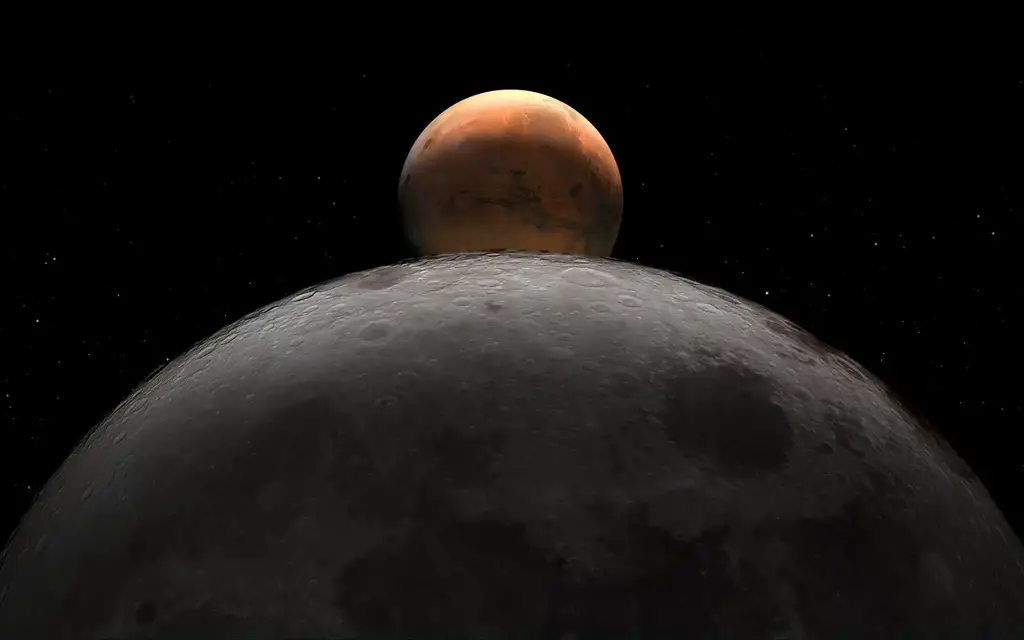The miracle of Mars moons was explained by the impact of a giant icy comet
- March 12, 2024
- 0
There are two versions of the origin of the moons of Mars, but none of them explains all the features of their composition and orbits. In a new
There are two versions of the origin of the moons of Mars, but none of them explains all the features of their composition and orbits. In a new

There are two versions of the origin of the moons of Mars, but none of them explains all the features of their composition and orbits. In a new study, scientists propose a solution to this mystery: a collision with an icy comet.
Mars has two moons: Deimos and Phobos. Both are quite “curved” in shape, more like asteroids than moons. They are most similar to asteroids in terms of other parameters: spectrum, intensity and surface reflectance (albedo). Therefore, according to one theory, Mars “caught” these objects as they flew. The problem is that their orbits were much longer then, and the Red Planet would not have had enough tidal force to “pull” them into modern circular orbits.
The second version of the origin of the Martian moons is a collision of the planet with a large object. Deimos and Phobos were then able to form in “correct”, circular orbits immediately from the debris disk. However, computer modeling of this scenario later reveals another object falling on Mars. Additionally, due to the high temperature, the debris in the disk should have melted, and we do not see such results in the materials of the satellites.
Scientists from Tokyo Institute of Technology (Japan) have proposed a solution. They added ice as part of the object that collided with Mars. The new scenario explained many characteristics of Deimos and Phobos. Astronomers presented the results of their work at the Lunar and Planetary Research Conference.
With the help of computer simulations, scientists checked the mass and composition of the disk resulting from the fall of an object with a mass of three percent of the mass of Mars and a different mass fraction of ice in its composition: 10, 30, 50 percent, etc.
As simulations show, a collision with an icy object always results in a disk with a larger mass than a collision with an ordinary meteorite. Perhaps this is because such objects initially have a larger radius. Another reason may be that the ice absorbs some of the energy, so more matter remains in the disk and does not fly into space.
Additionally, ice lowers the temperature in the disk below the melting point of silicates. Chondrite fragments of the icy body are then much more likely to survive the collision and remain in the disk. According to scientists’ assumptions, the moons of Mars are made of this material.
As the authors of the article note, objects that are 70 or 90 percent ice are best suited to the new scenario. There is no such solar system in the modern solar system, but analysis of the composition of asteroid Ryugu showed that its “father” consists of 20-90 percent water. So, when the collision occurred in the young solar system, it was quite possible to find an object consisting of two-thirds ice.
The team of scientists will continue to conduct experiments on the simulation of this collision. The researchers first plan to test the different composition of the rock component of the ice mass. They also want to track temperature changes during the collision to understand how this would affect the material in the disk.
And finally: astronomers will try to reduce body weight based on the results of their colleagues’ studies. In 2018, scientists calculated that a collision with a massive object somewhere between the asteroid Vesta and the dwarf planet Ceres was sufficient for the formation of Phobos and Deimos.
Source: Port Altele
As an experienced journalist and author, Mary has been reporting on the latest news and trends for over 5 years. With a passion for uncovering the stories behind the headlines, Mary has earned a reputation as a trusted voice in the world of journalism. Her writing style is insightful, engaging and thought-provoking, as she takes a deep dive into the most pressing issues of our time.